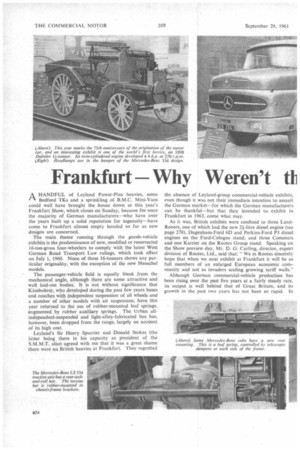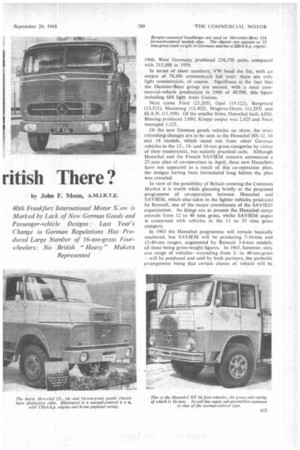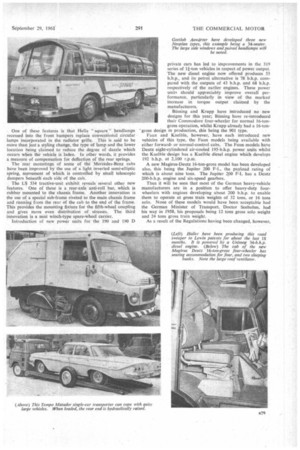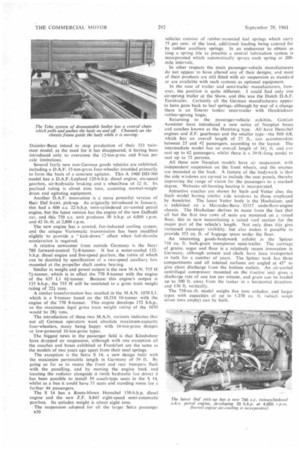Frankfurt Why Weren't ft ritish There?
Page 58

Page 59

Page 60

Page 63

Page 64

If you've noticed an error in this article please click here to report it so we can fix it.
by John F. Moon, A.M.I.R.T.E. A HANDFUL of Leyland Power-Plus heavies, some
Bedford TKs and a sprinkling of B.M.C. Mini-Vans could well have brought the house down at this year's Frankfurt Show, which closes on Sunday, because foronce the majority of German manufacturers—who have over the years built up a solid reputation for ingenuity—have come to Frankfurt almost empty handed so far as new designs are concerned.
The main theme running through the goods-vehicle exhibits is the predominance of new, modified or resurrected 16-ton-gross four-wheelers to comply with the latest West German Road Transport Law rulings, which took effect on July 1, 1960. None of these 16-tonners shows any particular originality, with the exception of the new Henschel models.
The passenger-vehicle field is equally bleak from the mechanical angle, although there are some attractive and well laid-out bodies. It is not without significance that Kassbohrer, who developed during the past few years buses and coaches with independent suspension of all wheels and a number of other models with air suspension, have this year returned to the use of rubber-mounted leaf springs, augmented by rubber auxiliary springs. The Urban allindependent-suspended and light-alloy-fabricated bus has, however, been dropped from the range, largely on account of its high cost.
Leyland's Sir Henry Spurrier and Donald Stokes (the latter being there in his capacity as president of the S.M.M.T. also) agreed with me that it was a great shame there were no British heavies at Frankfurt. They regretted the absence of Leyland-group commercial-vehicle exhibits, even though it was not their immediate intention to assault the German market—for which the German manufacturers can be thankful—but that they intended to exhibit in Frankfurt in 1963, come what may.
As it was, British exhibits were confined to three LandRovers, one of which had the new 2f-litre diesel engine (see page 278), Dagenham-Ford 6D and Perkins-Ford P3 diesel engines on the Ford-Cologne stand, and three Commers and one Karrier on the Rootes Group stand. Speaking on the Show preview day, Mr. D. G. Curling, director, export division of Rootes, Ltd., said that: "We in Rootes sincerely hope that when we next exhibit at Frankfurt it will be as full members of an enlarged European economic community and not as invaders scaling growing tariff walls."
Although German commercial-vehicle production has been rising over the past five years at a fairly steady rate, its output is well behind that of Great Britain, and its growth in the past two years has not been so rapid. In 1960, West Germany produced 238,370 units, compared with 215,100 in 1959.
In terms of sheer numbers; VW head the list, with an output of 78,486 commercials last year: these are only tight commercials, of course. Significant is the fact that the Daimler-Benz group are second, with a total com mercial-vehicle production in 1960 of 48,988, this figure including 688 light Auto Unions.
Next come Ford (21,205), Opel (19,122), Borgward (13,521), Hanomag (12,402), Magirus-Deutz (11,295) and M.A.N. (11,109). Of the smaller firms, Henschel built 4,924.
Bilssing produced 3,080, Krupp output was 2,425 and Faun managed 1,125.
Of the new German goods vehicles on show, the most refreshing changes are to be seen in the Henschel HS 12, 14 and 16 models, which stand out from other German vehicles in the 12-. 14and 16-ton gross categories by virtue of their modernistic, but entirely practical cabs. Although Henschel and the French SAVIEM concern announced a 25-year plan of co-operation in April, these new Henschels have not appeared as a result of this co-operation plan. the designs having been formulated long before the plan was, revealed.
In View of the possibility of Britain entering the Common Market it is worth while glancing briefly at the proposed programme of co-operation between Henschel and SAVIEM, which also takes in the lighter vehicles produced by Renault, one of the major constituents of the SAVIEM organization. As things are at present the Henschel range extends from 12 to 40 tons gross, whilst SAVIEM ouput is concerned with vehicles in the II to 35 tons gross category.
In 1963 the Henschel programme will remain basically unaltered, but SAVIEM will be producing 7-10-ton and 12-40-ton ranges, augmented by Renault 3-6-ton models, all these being gross-weight figures. In 1965, however, only one range of vehicles—extending from 3to 404on-gross ---will be produced and sold by both partners, the probable arrangement being that certain classes of vehicle will he
produced solely its the Henschel factory at Kassel. and others in the SAV1EM plant near Paris. with interchange of running units between the two.
It must be emphasized, however, that the Henschel-SAVIEM agreement was made with the object of forming a standard production programme covering light, medium and heavy commercial vehicles, with a common distribution network. It is a partnership, with neither concern controlling the other. Possibly the most important of the new Henschel vehicles are the 16-tonners, which are available with normalor forward-control, and have Henschel 192-b.h.p. diesel engines, allowing them to operate at 32 tons gross train weight in compliance with the German regulations demanding a minimum of 6 b.h.p, per ton gross. These HS 16 types have payload ratings of between 8 and 91 tons, according to wheelbase and type of body and, as demanded by German law, the rear-axle loading does not exceed 10 tons.
Similar in appearance are the HS 14-ton-gross 180-b.h.p. machines, the payload ratings of which range from 71 to 8 tons, or which can operate at a gross train weight of 30 tons. The smallest of the new Henschels is the HS 12, which has a 132b.h.p. diesel and a gross solo rating of 12 tons.
Striking new cabs have been developed for these otherwise reasonably conventional types, a particular feature of the cab design being that normal-control, forward-control and forwardcontrol-sleeper cabs all share a large number of common subassemblies. All the variations of this cab are well finished and look extremely comfortable, standard features including deo pendant pedals, heater and demister, padded sun visors, screen washers and neat " push-button " facia-panel switches to control not only the lights but also such mechanisms as the rear-axle-differential lock and. on 4 x 4s, the front-axle-drive engagement.
Daimler-Benz, A.G., are represented in this revival of the 16-ton-gross heavy-duty class by their 334 models which, in common with most German vehicles of this size, are available in normaland forwardcontrol configurations. The 334 has an export rating of 181 tons, and towing a trailer its maximum weight rating is 341 tons. It has a 200-b.h.p. engine ..ind several minor but interesting features which could well he incorporated eventually on lighter Mercedes-Benz chassis.
One of these features is that Hella " square ". headlamps recessed into the front bumpers replace conventional circular lamps incorporated in the radiator grille. This is said to be more than just a styling change, the type of lamp and the lower location being claimed to reduce the degree of dazzle which occurs when the vehicle is laden. In other words, it provides a measure of compensation for deflection of the rear springs.
The rear mountings of some of the Mercedes-Benz cabs have been improved by the use of a light inverted semi-elliptic spring, movement of which is controlled by small telescopic dampers beneath each side of the cab.
The LS 334 tractive-unit exhibit reveals several other new features. One of these is a rear-axle anti-roll bar, which is rubber mounted to the chassis frame. Another innovation is the use of a special sub-frame riveted to the main chassis frame and running from the rear of the cab to the end of the frame. This provides the mounting fixture for the fifth-wheel coupling and gives more even distribution of stresses. The third innovation is a neat winch-type spare-wheel carrier.
Introduction of new power units for the 190 and 190 D private cars has led to improvements in the 319 series of li-ton vehicles in respect of power output. The new diesel engine now offered produces 55 b.h.p., and its petrol alternative is 78 b.h.p. compared with the outputs of 43 b.h.p. and 68 b.h.p. respectively of the earlier engines. These power units should appreciably improve overall performance, particularly in view of the marked increase in torque output claimed by the manufacturers.
Bussing and Krupp have introduced no new designs for this year; Bussing have re-introduced their Commodore four-wheeler for normal 16-tongross operation, whilst Krupp already had a 16-ton' gross design in production, this being the 901 type.
Faun and Kaelble, however, have each introduced new vehicles of this type, the Faun models being available with either forwardor normal-control cabs. The Faun models have Deutz eight-eylindered air-cooled 195-b.h.p. power units whilst the Kaelhle design has a Kaelble diesel engine whiah develops 192 b.h.p. at 2,100 r.p.m.
A new Magirus-Deutz 16-ton-gross model has been developed also, this being the Jupiter 200 F-L, the payload rating of which is about nine tons. The Jupiter 290 F-L has a Deutz 200-b.h.p. engine and six-speed gearbox.
Thus it will be seen that most of the German heavy-vehicle manufacturers are in a position to offer heavy-duty fourwheelers with engines developing about 200 b.h.p. to enable them to operate at gross train weights of 32 tons, or 16 tons solo. None of these models would have been acceptable had the German Minister of Transport. Doctor Seebohm, had his way in 1958, his proposals being 12 tons gross solo weight and 24 tons gross train weight As a result of the Regulations having been changed, however, Daimler-Benz intend to stop production of their 333 twinsteer mode!, as the need for it has disappeared, it having been introduced only to overcome the 12-ton-gross and 8-Ion per axle limitations.
Several fairly new non-German goods vehicles are exhibited, including a D.A.F. 15-ton-gross four-wheeler intended primarily to form the basis of a concrete agitator. This A 1900 DD-360 model has a D.A.F.-Leyland 120-b.h.p. diesel engine, six-speed gearbox, air-hydraulic braking and a wheelbase of 12 ft. Hs payload rating is about nine tons. assuming normal-weight drum and agitating equipment.
Another D.A.F. innovation is a more powerful version of their Daf 6-cwt. pick-up. As originally introduced in January, this had a 600 c.c. 22-b.h.p. twin-cylindered air-cooled petrol engine, but the latest version has the engine of the new Daffodil car, and this 750 c.c. unit produces 30 b.h.p. at 4,000 r.p.m. and 42 lb.-ft. at 2,800 r.p.m.
The new engine has a cowled, fan-inducted cooling system. and the unique Variomatic transmission has been modified slightly to provide a "kick-down " effect when full-throttle acceleration is required.
A relative newcomer from outside Germany is the Steyr 780 forward-control 7I-8-tonner. It has a water-cooled 132b.h.p. diesel engine and five-speed gearbox, the ratios of which can be doubled by specification of a two-speed auxiliary box mounted at the propeller shaft centre bearing.
Similar in weight and power output is the new M.A.N. 735 H 71-tonner. which is in effect the 770 8-tanner with the engine of the 635 LI 6f-tonner. Because this engine's output is 135 b.h.p.. the 735 H will be restricted to a gross train weight rating of 221 tons.
A similar transformation has resulted in the M.A.N. 1070 LI. which is a 9-tonner based on the 10.210 10-tonner with the engine of the 770 8-tonner. This engine develops 172 b.h.p., so the maximum legal gross train weight rating of the 1070 would be 28i tons.
The introduction of these two M.A.N. variants indicates that not all German operators want absolute maximum-capacity four-wheelers, many being happy with 14-ton-gross designs or low-powered 16-ton-gross types.
The biggest news in the passenger field is that Kassbohrer have dropped air suspension, although with one exception all the coaches and buses exhibited at Frankfurt are the same as the models of two years ago apart from their steel springs.
The exception is the Setra S 14. a new design built with the maximum permissible length in Germany of 39 ft. By going so far as to recess the front and rear bumpers flush with the panelling, and by moving the engine back and locating the radiator alongside it (with hydraulic fan drive) it has been possible to install 59 coach-type seats in the S 14, whilst as a bus it could have SS seats and standing room for a further 44 passengers.
The S 14 has a Roots-blown Henschel 150-b.h.p. diesel engine and the new Z.F. S.845 eight-speed semi-automatic gearbox. Its unladen weight is about eight tons.
The suspension adopted for all the larger Setra passenger B30 vehicles consists of rubber-mounted leaf springs which carry 75 per cent, of the load, additional loading being catered for by rubber auxiliary springs. In an endeavour to obtain as long a spring life as possible a central lubrication system is incorporated which automatically sprays each spring at 200mile intervals.
In other respects the main passenger-vehicle manufacturers do not appear to have altered any of their designs, and most of their products are still fitted with air suspension as standard or are available with such systems as optional equipment.
In the case of trailer and semi-trailer manufacturers, however, the position is quite different. I could find only one air-sprung trailer at the Show, and this was the Dutch D.A.F. Eurotrailer. Certainly all the German manufacturers appear to have gone back to leaf springs although by way of a change there is an Esterer tanker semi-trailer with Hendrickson rubber-sprung bogie.
Returning to the passenger-vehicle exhibits, Gottlob Auwarter have introduced a new series of Neoplan buses and coaches known as the Hamburg type. All have Henschel engines and Z.F. gearboxes and the smaller type—the NH 6/8. which has an overall length of 27 ft.. can accommodate between 25 and 42 passengers. according to the layout. The intermediate model has an overall length of 341 ft, and can seat up to 62 passengers. whilst there is a 39-ft.-long model to seat up to 72 persons.
All these new Neoplan models have air suspension, with independent suspension on the front wheels, and the engines are mounted at the back. A feature of the bodywork is that the side windows are curved to include the cant panels, thereby improving the range of vision for the passengers to a marked degree. Webasto oil-burning heating is incorporated,
Attractive coaches are shown by Steib and Vetter also. the Steib model having similar s:de windows to those employed by Auwarter. The latest Vetter body is the Hochsitzer. and is exhibited on a Mercedes-Benz •0317 underfloor-engine chassis. The Hochsitzer derives its name from the fact that all but the first two rows a seats are mounted on a raised floor, this in turn necessitating a raised roof section for the major part of the vehicle's length. Not only does this give increased passenger visibility, but also makes it possible to provide 353 Cu. ft. of baggage space under the floor.
An interesting goods-bodywork exhibit is the Spitzer 710 Cu. ft. bulk-grain transporter semi-trailer. The carriage of grains, sugar and flour is a relatively recent innovation in Germany, although cement and chalk have been transported in bulk for a number of years. The Spitzer tank has three compartments and all internal surfaces are angled at 45° to give clean discharge from the bottom outlets. An air-cooled centrifugal compressor mounted on the tractive unit gives a discharge rate of one ton per minute, and grain can he loaded up to 500 ft. away from the tanker in a horizontal direction_ and 130 ft, vertically.
The 710-cu.-ft. model weighs five tons unladen, and larger types with capacities of up to 1.270 cu. 11. (which weigh seven tons empty) can be built.




















































































































